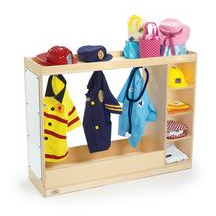It's official.
Summer is over!
My co-teachers and I have been working very hard (as I'm sure many of you have been) preparing for this time.
Parent handbook? Check.
Operation: "Clean and Organize?" Check.
Rearrange the classroom? Check.
We got this!
We agonized about the room arrangement. I really wanted to create a bigger art studio, but my original plan meant we had to move the library. This just would not work! The only other corners in the room were near a bathroom or an exit (high-traffic areas), and we still wanted to preserve the peacefulness of the cozy area. We finally managed to come up with an arrangement that fit all of our needs.
I am very pleased with how it turned out. I expect it to change throughout the year. We will add photographs of the children, rotate books, and display art and documentation. I'm sure we may try twinkly lights, or perhaps add more soft things.
Here is the beginning of a wonderful Library!
 |
| This is a commercially bought canopy from Discount School Supply. |
This was originally a canopy, not an entrance way. I had to fold the fabric in the back in half three or four times, until it was tall enough for an adult to fit through. (I intended to create a child-sized entrance, but I plan on spending time reading to individual children in this center throughout the year. For this reason, I made it adult-friendly.) I safety-pinned the fabric to make it stay folded.
My classroom has a low, drywall ceiling (just under ten feet), so I used a screw-in hook to attach it.
I tied the sides with a bit of yarn, and taped the yarn to the sides of the adjacent shelves. The fabric covers the tape, so it is still aesthetically pleasing, but the children are less likely to pull it down. It has been two full weeks, and so far, so good. (Knocking on wood!)


The artificial plant, (see-through) lace, and authentic-looking couch add a cozy touch to our library. The children may read individually or in small groups (no larger than three or four).
The shelf with the lace curtain above was originally a piece of dress-up furniture. It has a shelf on top for storage, six hooks for hanging clothes, and four more shelves down the right side for more storage. It has a full-length mirror down the left, outer side, similar to this:
I've re-purposed it as a "Peace Corner." The Peace Corner can fit two or three children at the most. It is a space for "hiding," but, of course, we are still able to see who is in there for safety reasons.
Behind the curtain there is a mirror, some pillows to make it cozy, and there are puppets for role-playing on the side shelves.
The following pictures are the resources I have printed and laminated for children. They are on the top shelf of the Peace Corner.
The Peace Corner is a peaceful area for those children who need a quiet spot to calm down, or for a couple of children who need help solving a conflict.
This is not a space for "time-out." I am very firm about this. When I bring children to this area, I make sure to let them know they are not in trouble. This is a place of peace and problem-solving. For more information about my child-guidance philosophy, click
here.
First the children may point to the picture that shows how they are feeling. If they are angry or frustrated, we read the
Tucker Turtle story together.
Tucker Turtle Takes Time to Tuck and Think is a free resource you can download
here. It is a social story I use to teach children self-regulation.
After we read Tucker Turtle, the child or children may pick a solution from the Solution Kit. I organized the solutions by type of problem:
"If you want something someone else has, you may..."
"If someone else wants something you have, you..."
"If someone is bothering you, you may..."
The solution kit doesn't solve every problem out there, but with consistency it can become a means to teach the children that there are many ways to solve any given problem. Having three solutions available to choose from narrows it down for the children, and streamlines the process.
You may now exit the Library/ Peace Corner.
:)
I will be posting more pictures of my classroom setup soon!
Happy playing!



















